
Today we begin to leave our neighborhood to examine the other "terrestrial" planets: Mercury, Venus, and Mars. First, lets review the basic information on the Earth-Moon system. The equatorial radius of the Earth is 6,378 km, and that for the Moon is 1,738 km. How far away is the Moon? The Moon's average distance from the Earth is 384,000 km (about 60 Earth radii). Here is (a complicated) figure showing the true scale of the Earth-Moon system:

The Moon's orbit is tilted ("inclined") by 5o (degrees) from that of the Earth, and this tilt is why we do not see solar and lunar eclipses at every New and Full Moon. The Earth orbits the Sun on an ellipse, whose semi-major axis is 149,600,000 km! Kepler's first law states that the Sun is located at one "focus". That means the Earth sometimes gets closer to the Sun than other times. How much does this change? The deviation of an ellipse from a circle can be measured using a term called "eccentricity". Eccentricity is simply how "non-round" an orbit is. The eccentricity of the Earth's orbit is only 0.017, thus the Earth is about 2.5 million kilometers closer to the Sun during its closest approach (called "perihelion"), and 2.5 million kilometers further from the Sun at its most distant ("aphelion"). For those still confused about the seasons, note that the Earth reaches its closest approach to the Sun, perihelion, on or about January 3rd every year--during Northern Hemisphere winter!!! The distance from the Sun does not play a major role in our seasons.
Before we go too much further, we need to define one more term: the "Astronomical Unit" (AU). Since it is hard to remember the (average) distance of the Earth to the Sun, astronomers get around this by defining this distance as "One AU". One AU = 149,600,000 km. We will use this number almost exclusively when talking about the other planets. It is much easier to deal with the huge sizes of planetary orbits using AU's.
Mercury is the closest planet to the Sun, with an orbit whose semi-major axis is 0.387 AU (that is 57.9 million km), and it only takes 88 days to go around one complete orbit. Its equatorial radius is 2,432 km (1.4 times that of the Moon), and rotates once on its axis every 57.3 days. Mercury does not have a moon. Mercury has no real atmosphere, and has a surface that closely resembles the Earth's Moon:

Mercury is heavily cratered--even more than our Moon. Mercury is also very dense, with a density of 5.5 gm/cm3--about the same density as the Earth. The lack of an atmosphere, and the nearness to the Sun imply very high tempertures on the "day side" of Mercury: it has a mean daytime temperature of 700 K! While the face of Mercury in sunlight is very hot, the other side is very cold, just 100 K, due to the lack of an insulating atmosphere. The reason Mercury has no atmosphere is that it is too small to hold onto an atmosphere being this close to the Sun. Only a very massive planet could keep an atmosphere with this much solar heating.
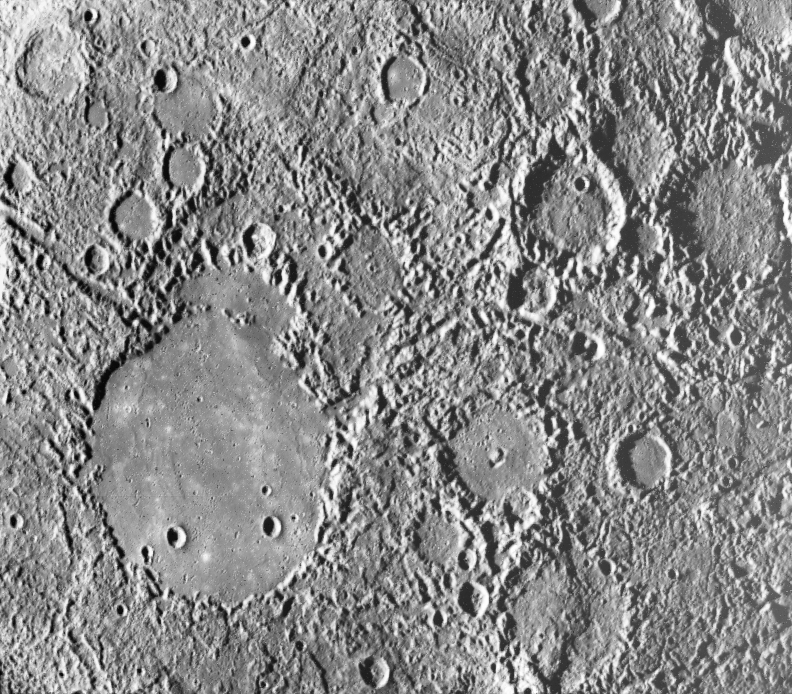
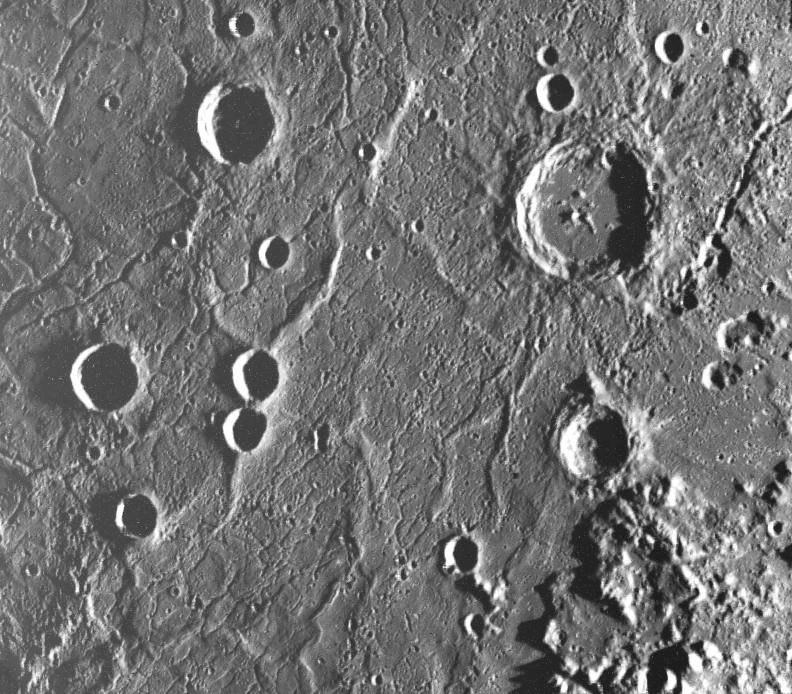
Note that when we discussed the structure of the Earth, we found that the inner core of the Earth was mostly iron, while the outer crust and mantle had a much lower density. The small size and high density of Mercury implies that iron is the dominant constituent of the planet. In fact, the silicate crust/mantle on Mercury is probably only 500 km thick, the rest being an iron core. It is likely that some of this core is still molten. There is evidence for "recent" (in a geological sense) volcanic activity on Mercury, but only one space probe (Mariner 10) has ever visited this planet, so we do not yet know how recent this activity was (go here for more on interpreting Mariner 10 images). A new probe has been launched, called Messenger, that will eventually orbit Mercury in 2011 (it is actually hard to get to Mercury, and you can read about the probe's trip at the NASA site). Here are two recent images:

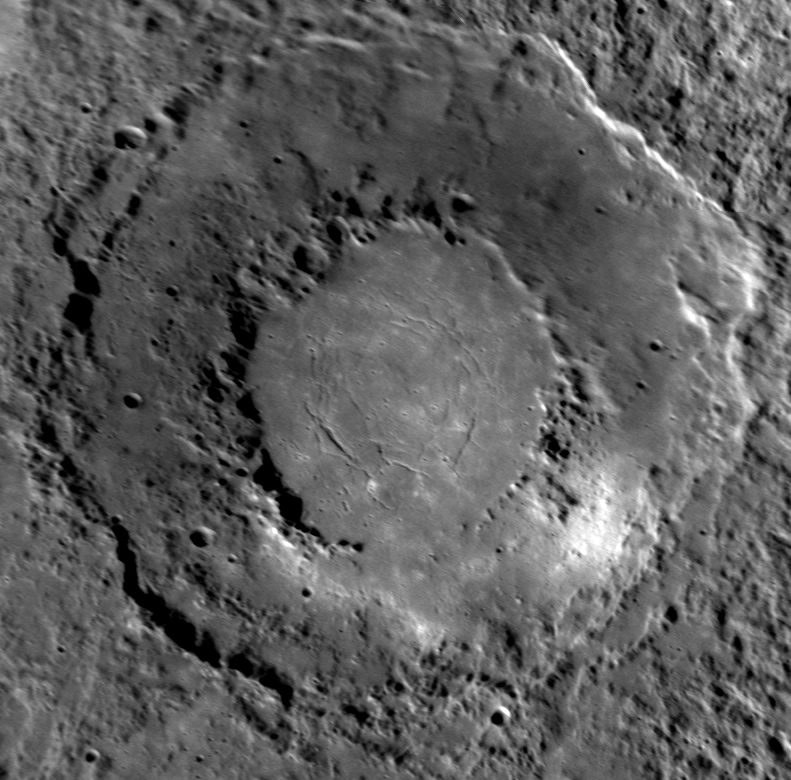
Mercury is the hardest of the naked-eye planets to see because it is never very far from the Sun. In fact, the greatest separation the two objects ever achieve is 28o, so at best Mercury sets about two hours after the Sun---it is rarely visible in a completely dark, nighttime sky. The best chance to view Mercury during Spring 2010 is early April: Mercury will be at a greatest Eastern Elongation on April 8th. At this time, Mercury will be seen low in the west after sunset. Because Mercury orbits inside that of the Earth's orbit, it shows phases like the Moon. But because it is always close to the Sun, very little detail can be seen through a telescope. Every once in a while, Mercury can be seen "transiting" the Sun. This is a lot like an annular solar eclipse, but in this case, Mercury is so far away that it is only seen as a small, black dot, here is the "grazing" transit of 1999 (a blow up of the solar limb showing a close-up of Mercury is to the upper left):
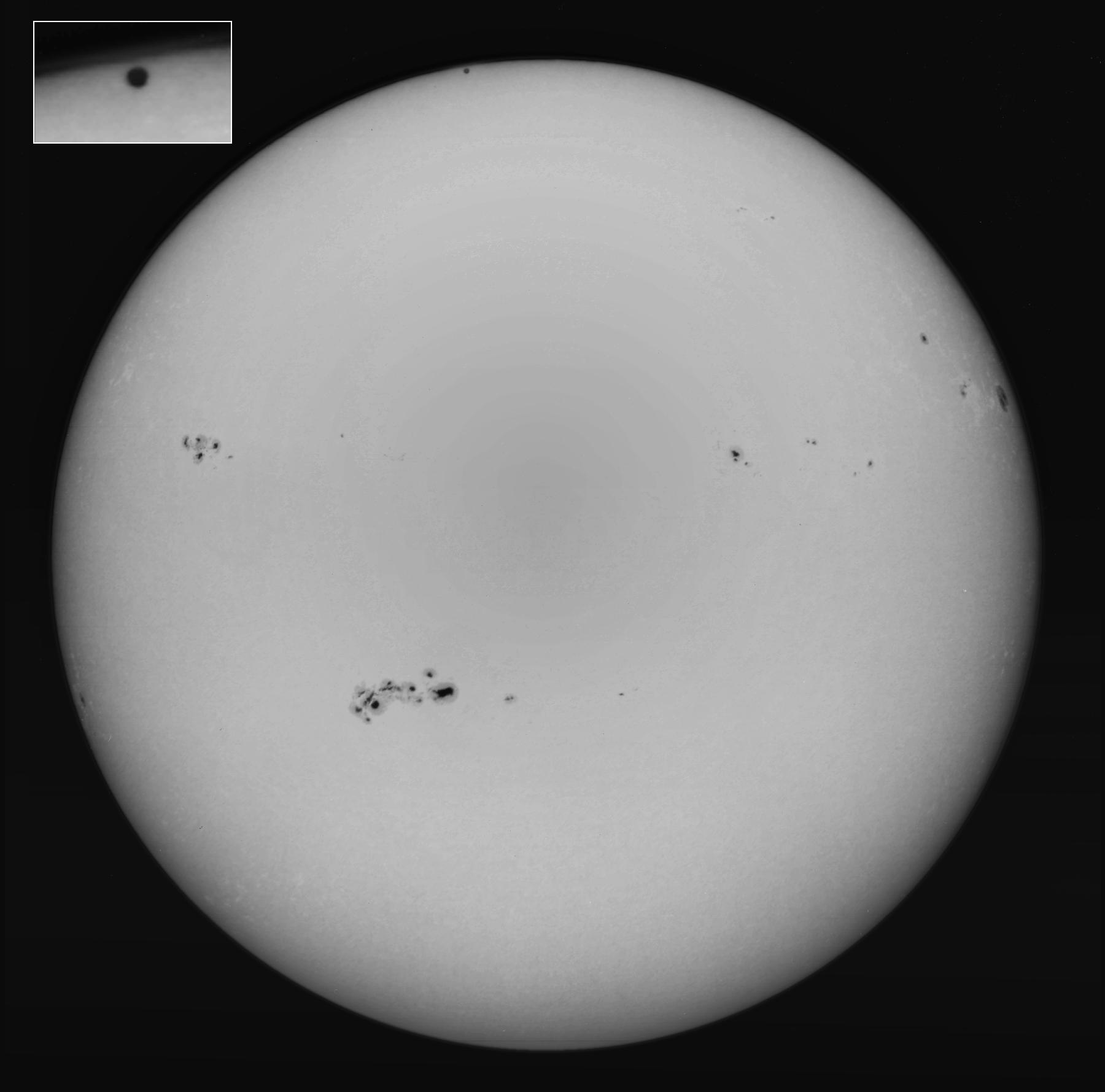
This picture really shows you the scale of the Sun--how insignificant a planet like Mercury (or the Earth) is when compared to the Sun! These events are rare, with about 12 per century. The last transit of Mercury occurred on 8th November, 2006, and was visible from New Mexico. The next one does not occur until May 9th, 2016.
Venus orbits the Sun at an average distance of 0.72 AU (108,200,000 km), and is almost the same size as the Earth: 6,051 km (vs. 6,378 km for the Earth). The mean density of Venus is 5.2 gm/cm3, is lower than both the Earth and Mercury. For a long time, Venus was referred to as the "Earth's twin". But we will find it is not very Earth-like! The orbital period of Venus is 225 days, and it rotates very slowly--once every 243 days (and in a "backwards" direction). Venus does not have any natural satellites. Venus has a very dense atmosphere, and the surface is not visible to us:

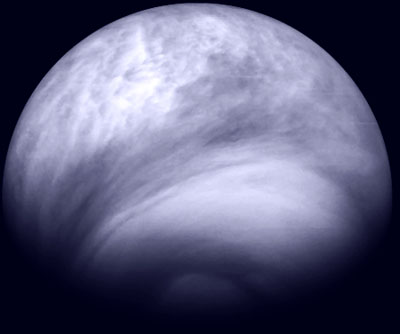
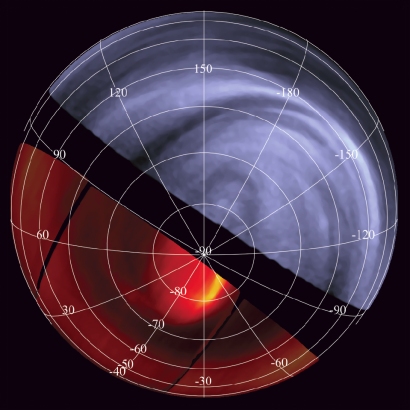
The atmosphere is mostly carbon dioxide (96%), and there appears to be very little water. The atmosphere is so dense, that at the surface of Venus the pressure is equivalent to that of being at a depth of 1 km in the ocean (90 "atmospheres"). This dense atmosphere is responsible for the enormous greenhouse effect on Venus, causing the surface temperature to be 740 K (hot enough to melt lead):
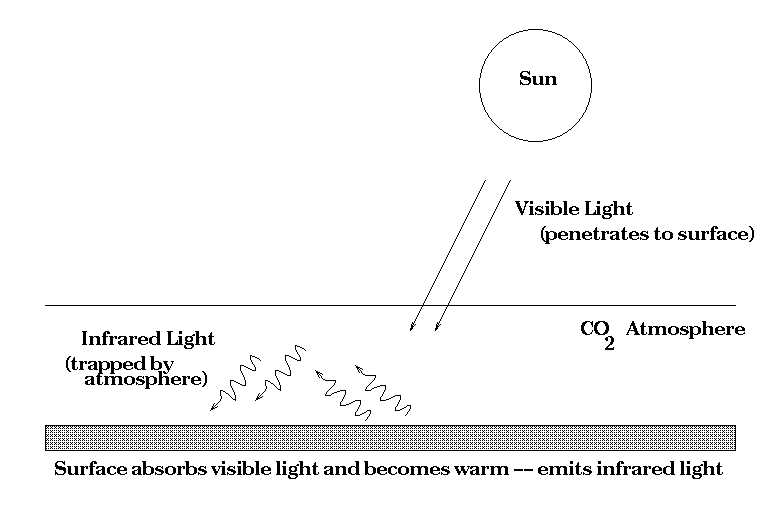
The runaway greenhouse on Venus means that the nighttime and daytime temperatures do not change much, even though the "nights" are 121 Earth-days long! The surface of Venus has a quite a few recognizable features, and a number of geologically unique structures that were mapped using radar:
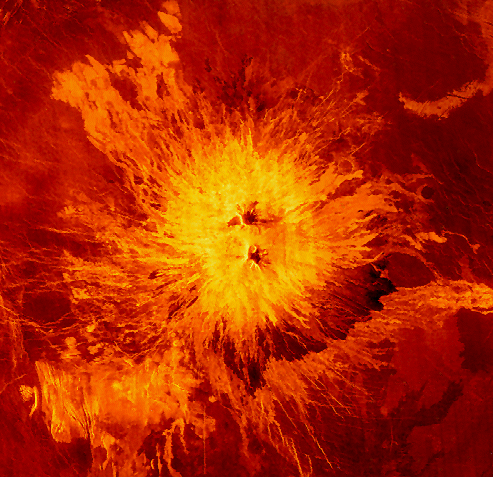


The atmosphere of Venus is thick enough that only the large meteors can penetrate, thus Venus has very few small craters. These radar images show that most of Venus' surface is covered with lava flows, indicating that Venus was quite geologically active in the distant past. There still may be a few "hot spots" that are active even today. The oldest Venusian terrain seems to be about 800 million years old, thus Venus has one of the youngest surfaces of any of the planets. Venus has an iron core about the same size as Earth's, but has a thicker and stronger crust that appears to show signs of plate tectonics.
Venus is the brightest star-like object in the nightime sky, appearing in the west after sunset, or in the east before sunrise. Currently, Venus can be seen in the southwest after sunset. It sets about 2 hrs after the sun. It will continue to get higher in the sky throughout the semester, reaching greatest eastern elongation on June 8th, 2007 (at this time it will not set until about 11:00 pm). In a small telescope, Venus reveals phases that range from "full" to a thin crescent. The view using a small telescope is shown below (note that the change in size is real, as Venus is furthest from the Sun at "full", and as it passes between us and the Sun--the crescent phases--it is closest to Earth, and appears larger):

It was these changing phases that helped Galileo show that the heliocentric theory of Copernicus was correct. Like Mercury, Venus can sometimes pass between the Earth and the Sun, creating a transit. The transits of Venus are much rarer than those of Mercury, and happen at intervals of 8 yrs, then 105.5 years, and then 121.5 years! One of these transits occurred on June 8, 2004, the next transit will take place on June 6, 2012. After that one, there will not be another until December 11, 2117! These events are much more interesting than those of Mercury because Venus is much larger, and it has an atmosphere (creating interesting optical effects), here is a diagram to scale:
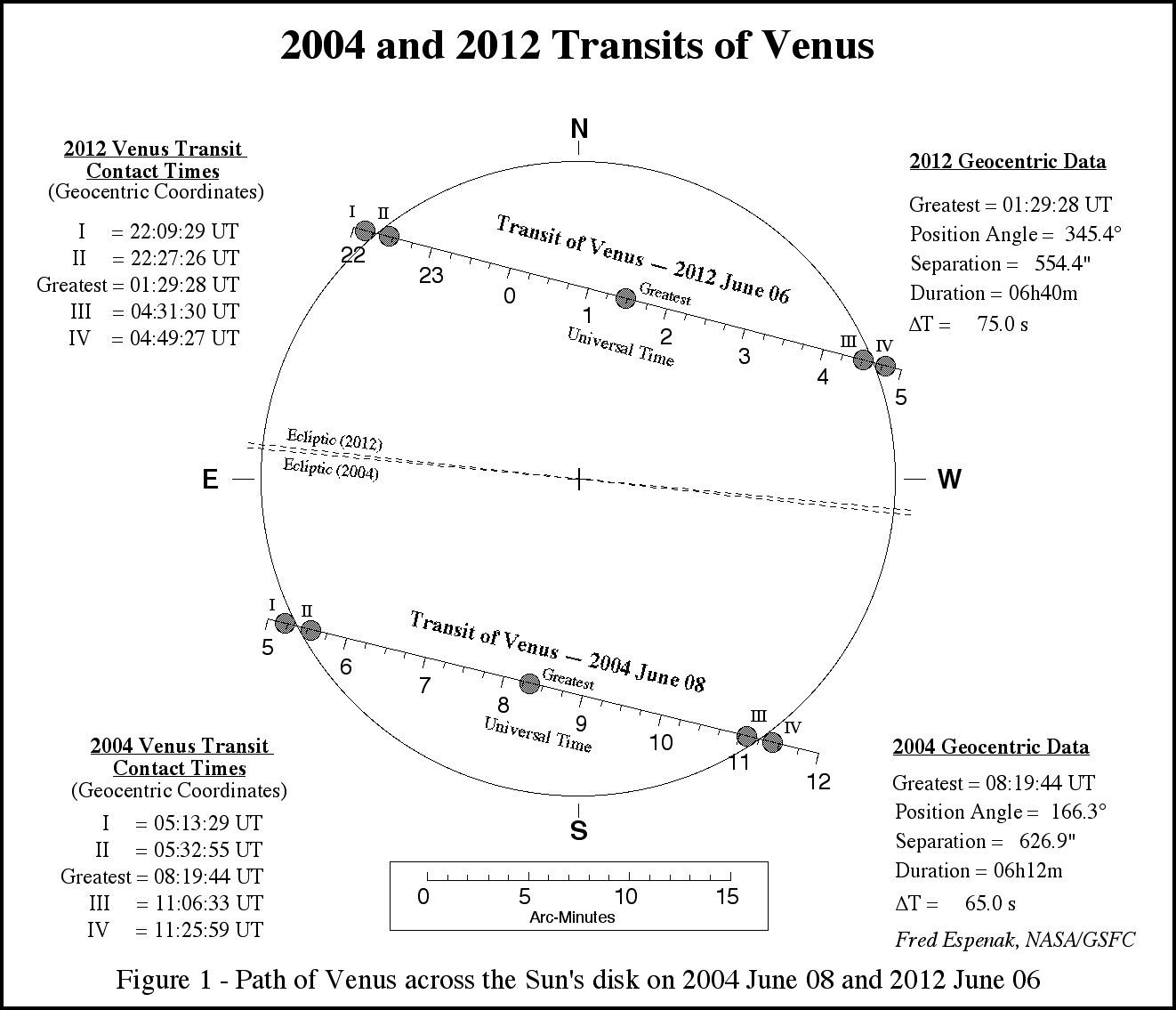
The 2012 transit will be visible from New Mexico, though as this map shows, we will not see the whole thing, but it will be interesting to see the sun setting with Venus on the disk (as pictured below).
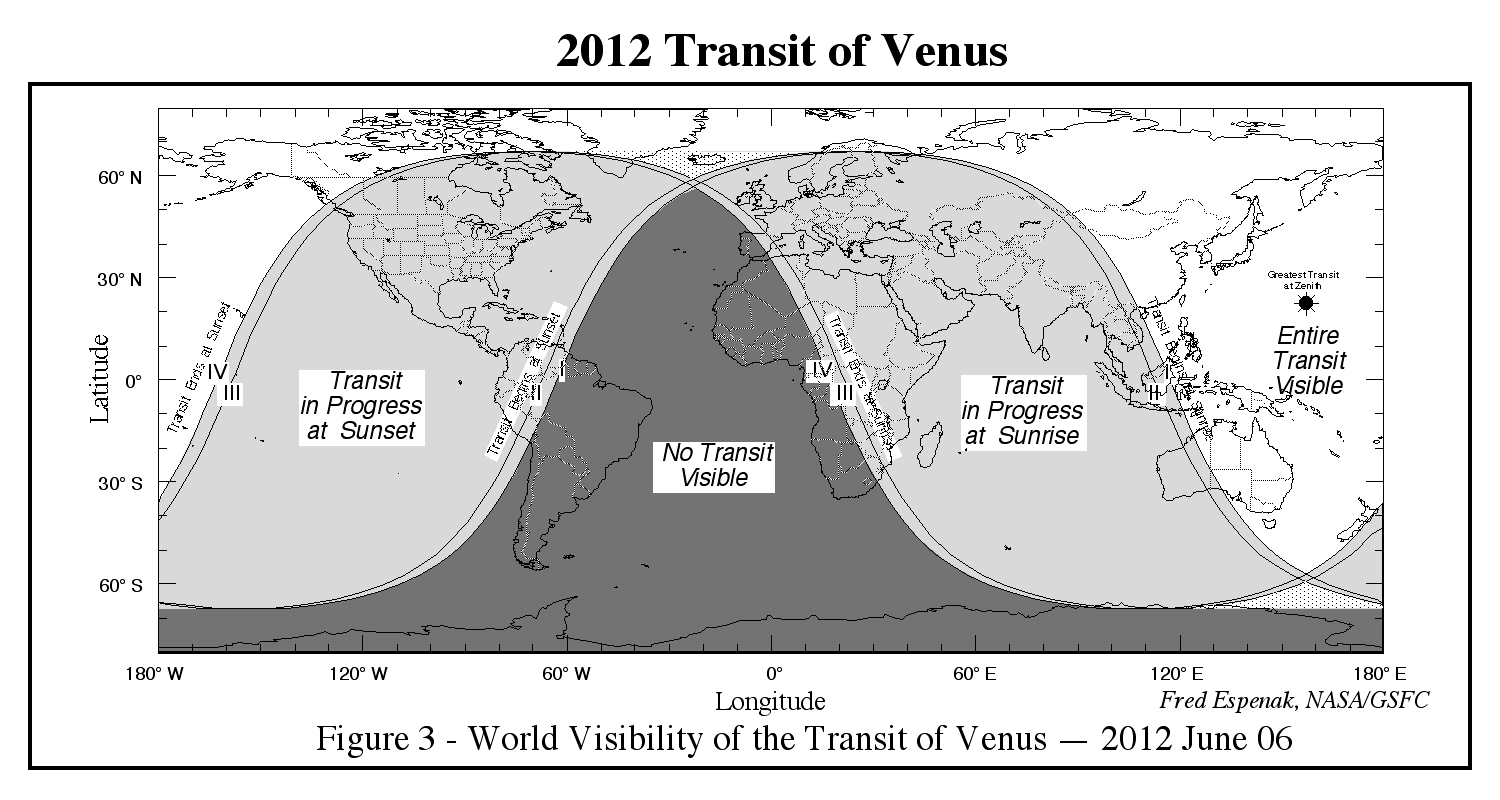
Here are some images of the Venus transit:
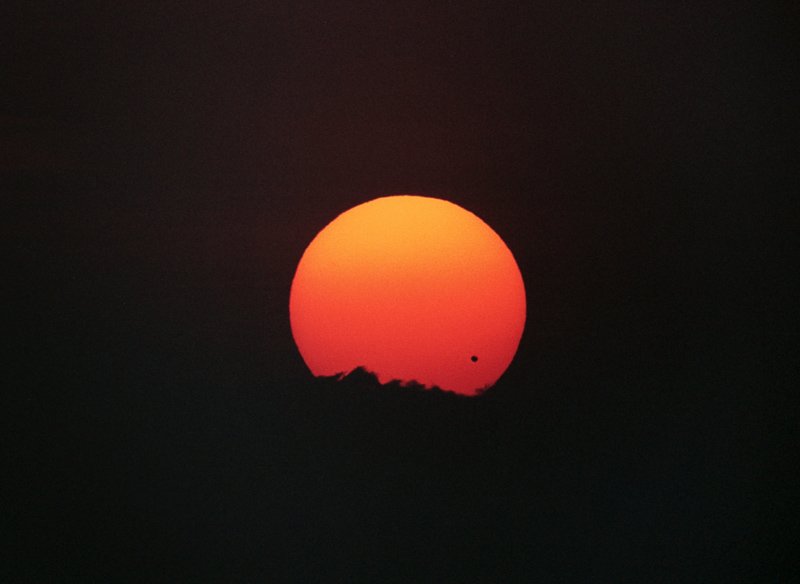
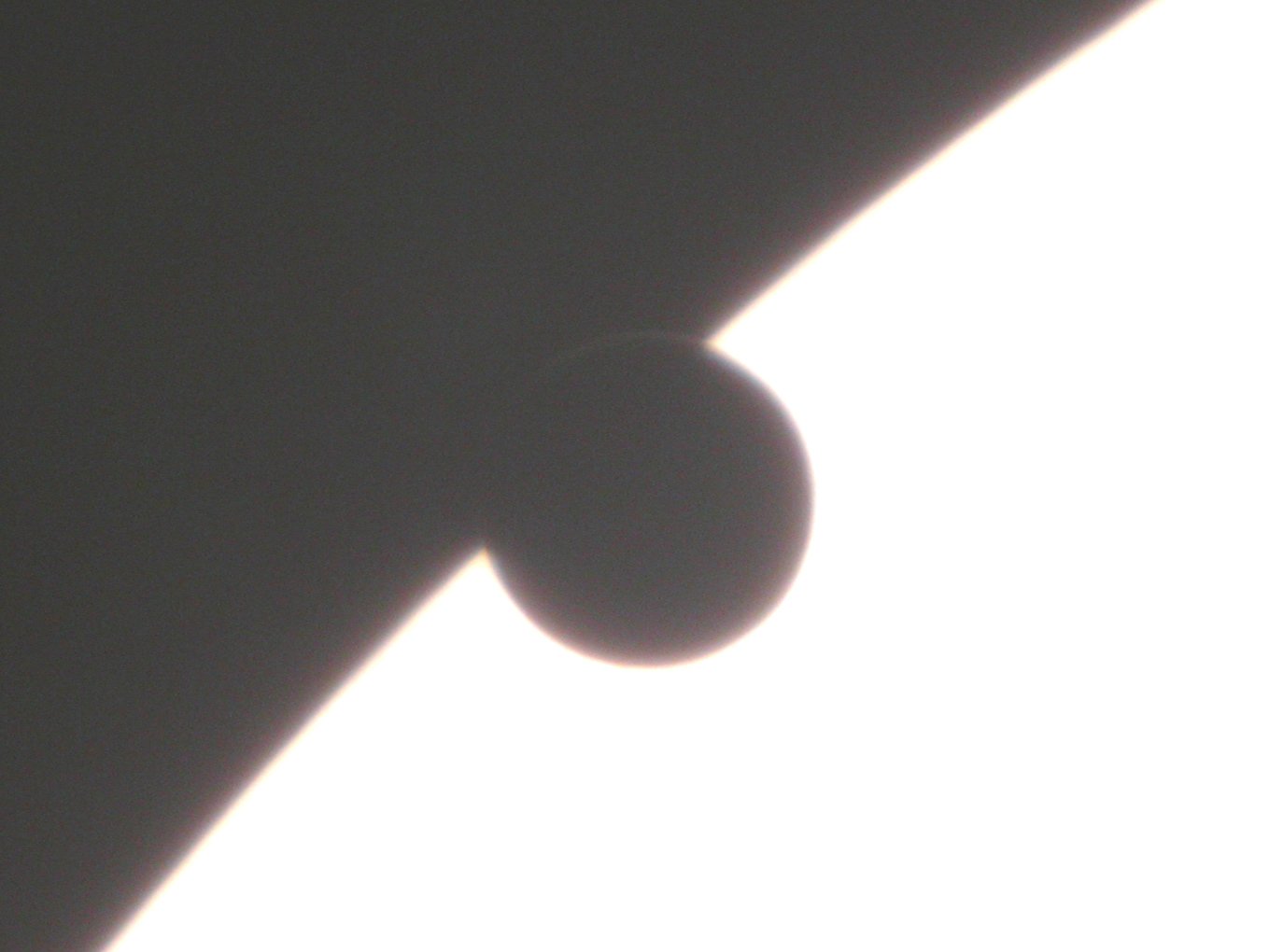
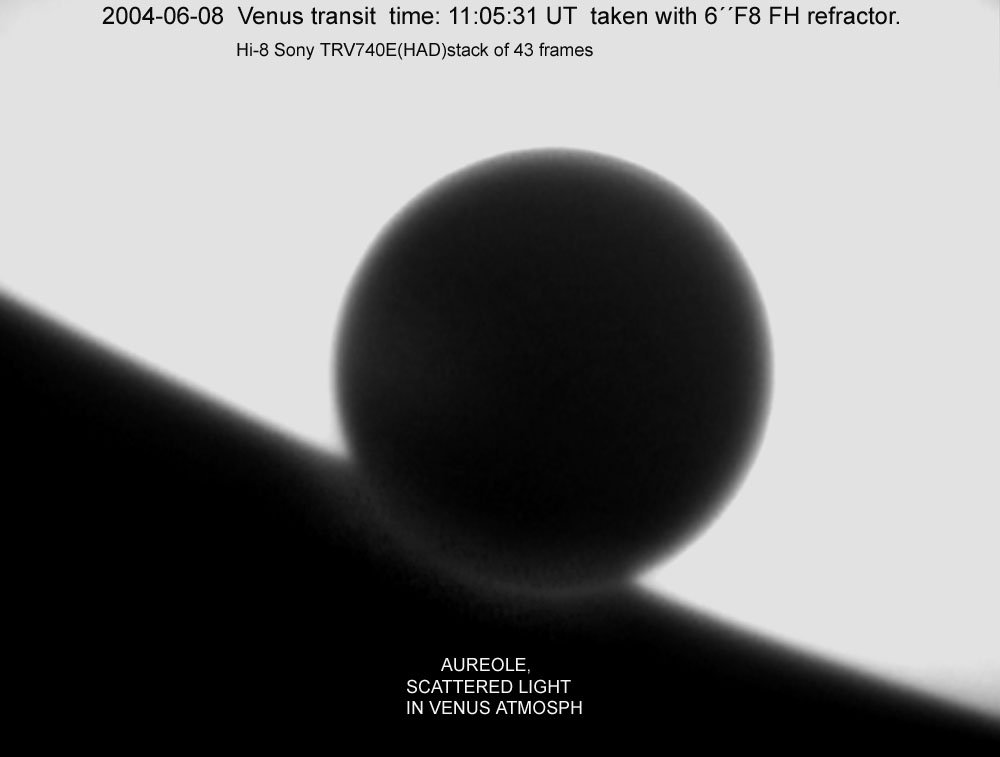
(For more images of this event go here.)
Of all of the planets, Mars has always been the one place in the solar system where scientists speculate we might find life. Mars is much smaller than the Earth, having an equatorial radius of 3,397 km (about 1/2 that of Earth). The density of Mars is 3.9 gm/cm3, just a bit higher than the Earth's Moon (3.34 gm/cm3). It orbits the Sun at an average distance of 1.52 AU (227,940,000 km). Mars takes 687 days (1.88 Earth years) to orbit the Sun. The length of the Martian "day" is nearly the same as Earth, as Mars rotates once per 24 hours and 37 minutes. Even though it is much smaller than the Earth, because of the latter's oceans, the total land surface area of Mars is just about the same.

Mars has a very tenuous atmosphere, composed mostly of carbon dioxide:
Martian air contains only about 1/1,000 as much water as our air, but even this small amount can condense out, forming clouds that ride high in the atmosphere or swirl around the slopes of towering volcanoes. Local patches of early morning fog can form in valleys. At the Viking Lander 2 site, a thin layer of water frost covered the ground each winter.1
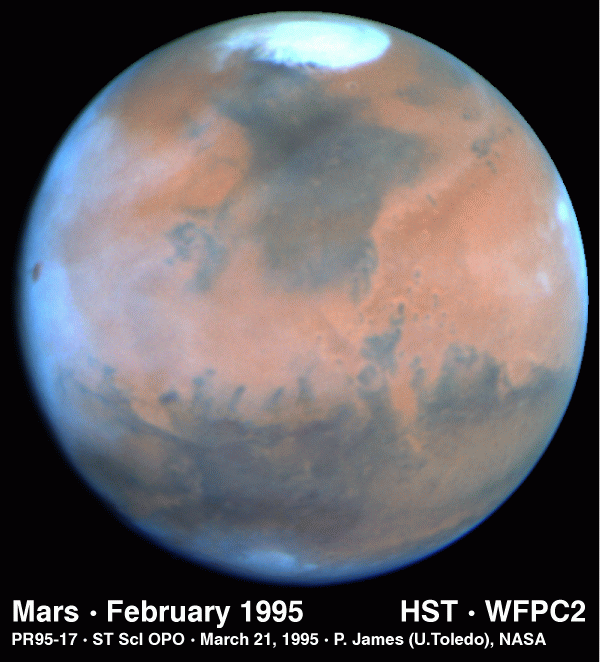

The average temperature on Mars is -63° C (-81° F) with a maximum temperature of 20°C (68° F) and a minimum of -140° C (-220° F).
Barometric pressure varies at each landing site on a semiannual basis. Carbon dioxide, the major constituent of the atmosphere, freezes out to form an immense polar cap, alternately at each pole. The carbon dioxide forms a great cover of snow and then evaporates again with the coming of spring in each hemisphere. When the southern cap was largest, the mean daily pressure observed by Viking Lander 1 was as low as 6.8 millibars; at other times of the year it was as high as 9.0 millibars. The pressures at the Viking Lander 2 site were 7.3 and 10.8 millibars. In comparison, the average pressure of the Earth is 1000 millibars.2
There is certainly water on Mars, some of it locked into the polar caps (though much of what we see in the Martian polar caps is actually frozen carbon dioxide--"dry ice"):
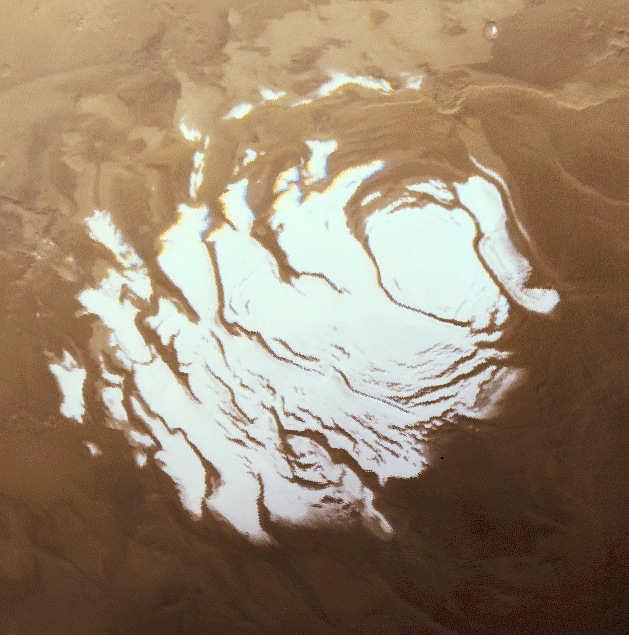
There are a large number of features on Mars which suggest the possibility of flowing water in its past:
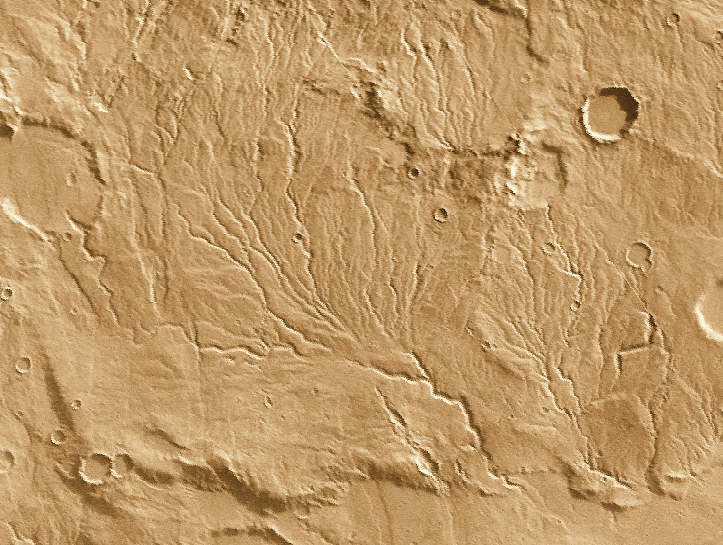
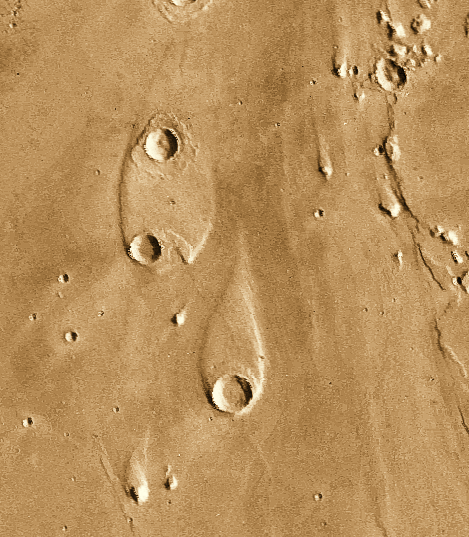
Here is an image of a dust storm rolling across a small region of Mars:
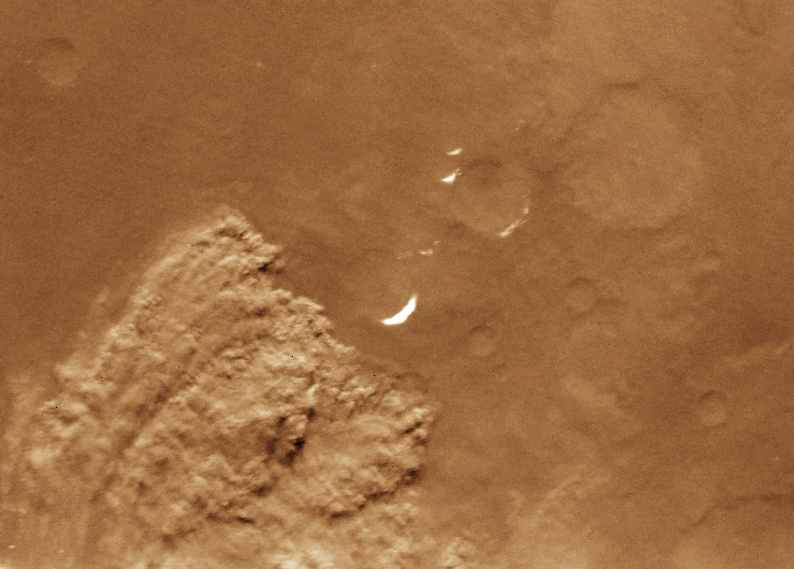
Mars has a surface that spans features common to the Moon and Earth. For example, like the Moon, there are many impact craters on Mars. But Mars has some of the forces of erosion like those seen on Earth (wind, freezing-thawing cycles), so these features are slowly eroded away. In addition, in the distant past Mars had volcanoes. In fact, the largest volcano in the solar system is on Mars, Olympus Mons:

Olympus Mons has a diameter of more than 500 km, and towers to 25 km above the surrounding terrain. It is a lot like the Hawaiian volcanoes, but Olympus Mons is much larger. For example, the "Big Island" (Hawaii) is only about 120 km across, and only rises 9 km (from the ocean floor). The lower gravity on Mars (due to its small mass) allows the volcanoes to grow beyond what is possible on the Earth.
There is considerable evidence that just below the Martian surface, there are considerable amounts of frozen water (go here for a recent press release). Here is a picture of a trench dug in the polar region (Mars Phoenix lander):
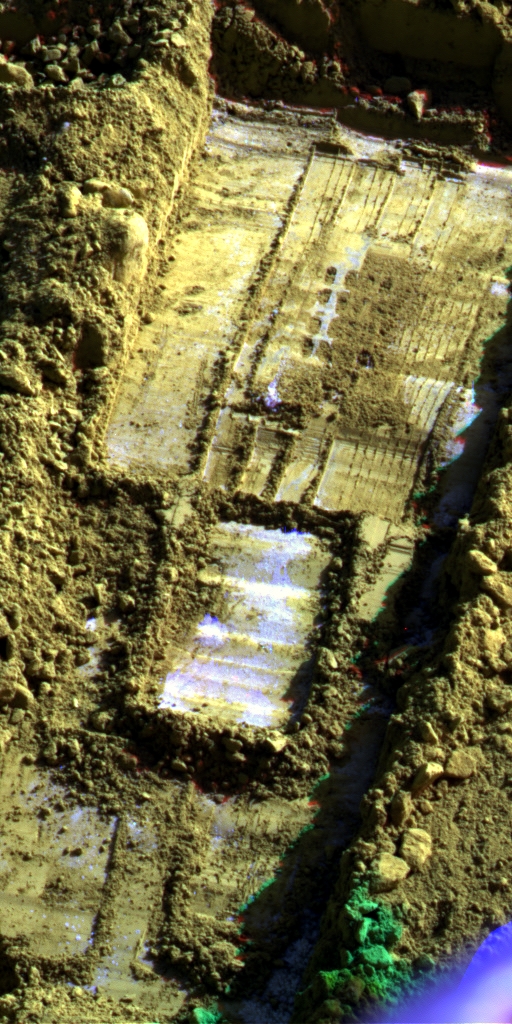
This, combined with the abundant evidence for water at earlier times in the history of Mars, suggests that it might have been possble for life to have evolved on Mars. Perhaps, like the "extremophiles" on Earth, this life now lies buried deep below the surface of Mars where the temperatures are much more hospitable. Many of these ideas are summarized in this document. We will discuss this topic more fully at the end of the semester.
Because Mars' atmosphere is so thin, an efficient greenhouse effect does not operate on Mars. There may have been periods in the past when Mars was warmer where much of the carbon dioxide locked into the poles (and elsewhere) was released, making it possible for this to happen. This may happen again in the future, but the exact mechanisms driving these long term climatic cycles have not yet been identified. Many people, however, are now proposing the idea of turning Mars into a warmer, wetter place. This is the concept of "terraforming". Through various means, much of the carbon dioxide locked away in the crust/poles is released, creating a thicker atmosphere with a more efficient greenhouse effect. The planet would thus warm up, and the atmosphere would become even denser. Eventually, it should support liquid water. Here is an academic thesis on terraforming Mars (showing how seriously some people take this), and here is a down-to-Earth description of how it might work.
Mars has two tiny moons, Phobos and Deimos (10 and 6 km in radius, respectively). These moons are so small that gravity cannot force them to be spherical, and they look like potatoes, here is Deimos:

An extreme close-up of the surface of Deimos shows that it is covered with a thick layer of dust, burying many of the craters (the smallest features in this photo are about the size of a car):
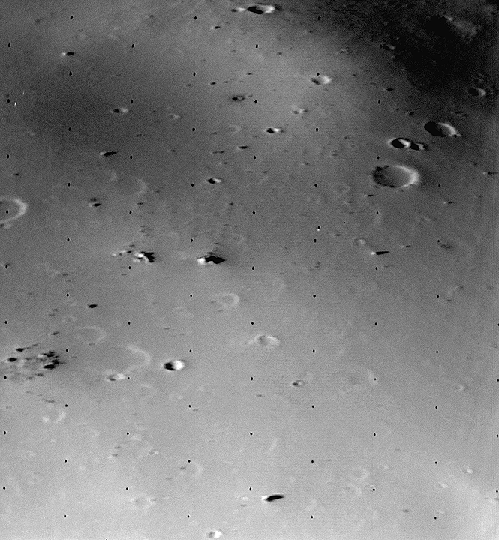
While the two moons of Mars are hard to see, Mars itself is one of the brightest planets in the sky (when it is close to Earth). Mars has been visible this semester, but is now slipping behind the earth, and out of view. It will not come around again for two years (spring 2012).
Some Mars rover images:




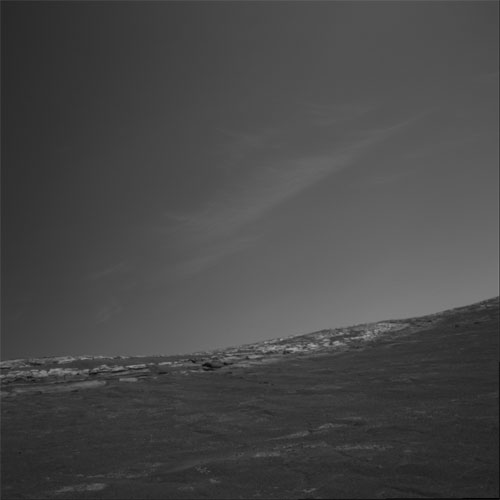
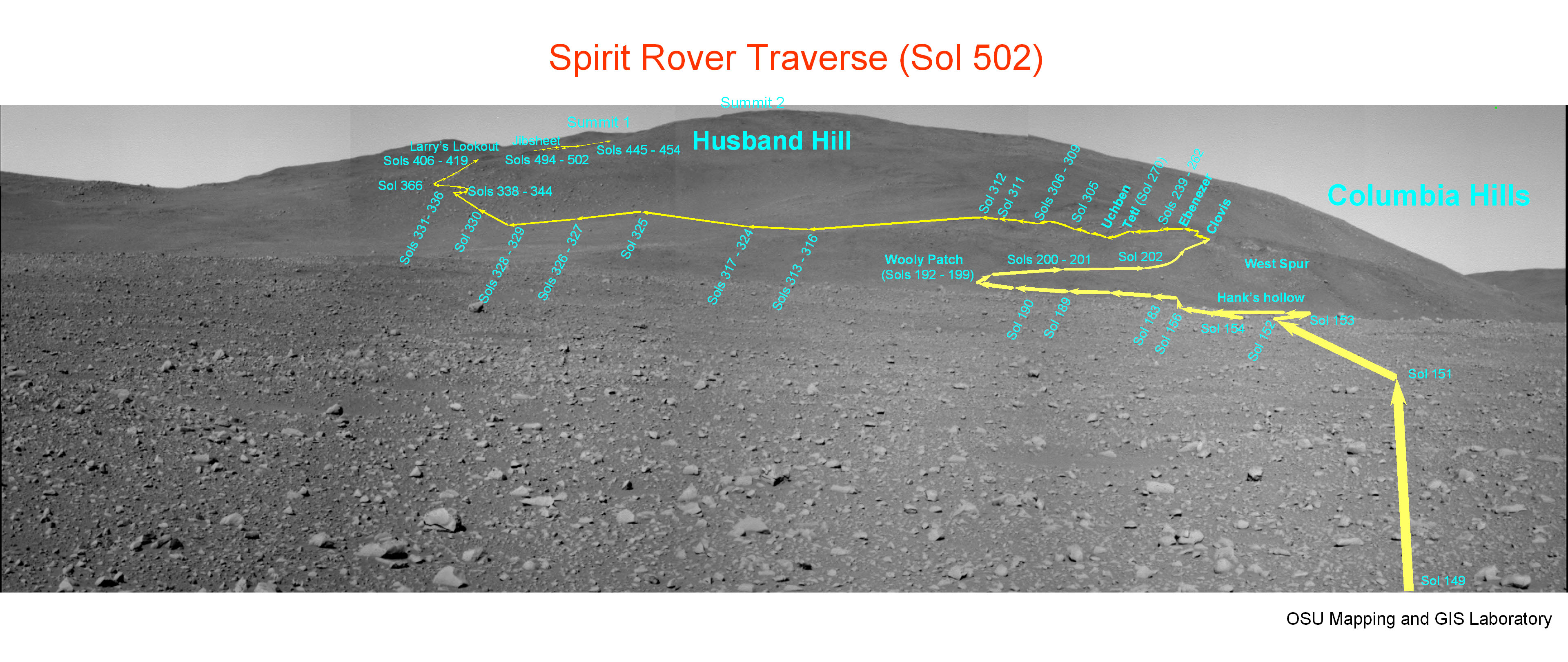

Dustdevil movie (#1), Dustdevil movie (#2), link.
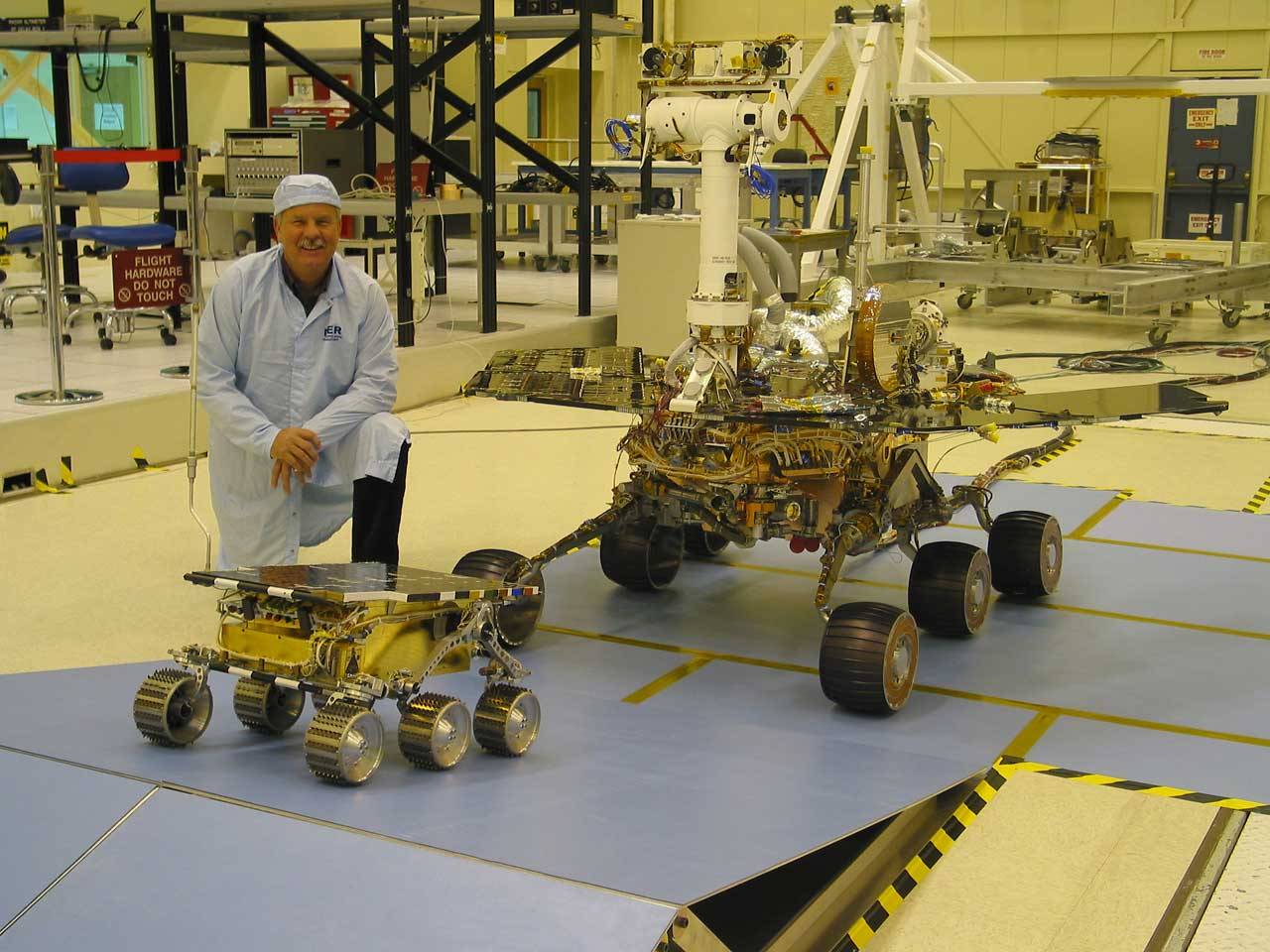
For more on the Mars rovers, go here.
1From Mars